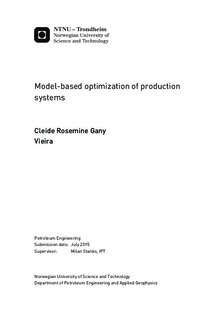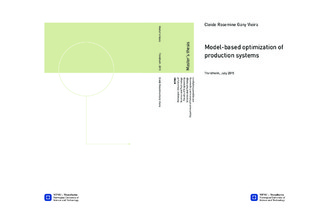| dc.description.abstract | Gas lifted method is one of the artificial lift technique used in the oil and gas industry.This method is applied most in oil well to improve the oil recovery by lowering the bottomhole pressure.
Normally in the field there are multi-gas lifted wells that requires certain amount of gas to be injected to achieve the maximum oil production. Generally the amount of gas available is limited, therefore is has to be allocated per well in the best way possible to achieve maximum oil production in the system. The problem of determining gas lift allocation per well to ensure maximum oil production can be formulated and solved as a mathematical optimization.
The results of the optimisation is a optimum gas injection rate that yield the maximum oil production for group of wells, this is important because excessive gas injected into the well can reduce the oil production and increases operation cost.
For a group of gas lifted wells there are two possible methods to perform the optimisation. Method 1, by assuming that the well operating conditions (i.e. wellhead pressure) of each well in the system will not be affected by the neighbouring wells and using pre-computed gas lift performance curves of each well. In method 2, the case is usually solved using a mathematical optimisation routine and a model of the entire production system.
To achieve the main goal of the present thesis, optimisation for an ideal production
network with five gas lifted wells has been modelled in Excel with data generated in
PROSPER for the case of method 1 and in GAP optimisation software for the case of
method 2. Therefore a deviation between the methods were calculated and presented in
percentage for better analyses and observations. Through the results presented in this thesis the value of the total oil production found using method 1 can in some cases be close to the value in GAP optimisation (method 2), but in another hand the injected gas per well differ from each other in the same system. The deviation found for the case of injected gas per well increases proportional with the amount of gas available in the system.
For the optimisation using method 2, three different model schematic were created,
and the model without an pipeline showed to be the system with more oil production,
due to the location of the separator that does not contribute for the pressure loss in the system. The second model (GAP-2) have the lower production in comparison with all the model, cause by the pipeline length distance (12km) that affect the pressure loss during the production.
In method 1 two different techniques were used for the optimisation, the piecewise-
linear optimisation and the curve fitting. The calculation shows that the piecewise-linear has high deviation value compared with the curve fitting technique, being better to use the curve fitting to calculate the optimisation when the constant wellhead assumption is used. Curve fitting techniques two equations were used to t the gas lift performance curve data (generated in PROSPER), the Alaracon et al. and Rashid et al. The Rashid et al. equation was observed to be the best representative of the gas lift curve in all the scenarios and the deviation tended to be lower than one found using the other equation.
If the number of iteration and time taken for each system to reach the optimum
point is considered, the curve fitting technique using Rashid et. al. equation takes less time and iteration number comparing with other techniques in method 1. For the case of optimisation using method 2 those values change in all scenarios and model, is not constant trend.
The study shows that, if a optimisation using method 1 is done for a system with
wells having high values of gas injection (more than 10 scf/D) to achieve the maximum
oil production, the deviation between the methods (Excel and GAP models) will be
more than 10%. This also when the data generated from PROSPER have more than 2000STB/D as maximum oil production per well. If the data generated containing gas
injection greater than zero at the beginning of GLPC is used in method 1 optimisation
the deviation can be more than 30% when all wells in the system present the same
characteristic.
The deviation calculated between the method 1 and method 2 is lower for the system
using the third model schematic in GAP where pipelines were added. The total oil
production is lower than the first model and greater than the second model, making the value more approximated to the optimum found in method 1.
In optimisation using method 1 if the wells data from gas lift performance curve
present low oil production and gas injection, the value of coefficients in equation of Alaracon and Rashid are almost the same and the deviation calculated using this well will be lower. For wells having the value of coefficient different the deviation calculated will be high, this is the case of well with gas injection greater than zero at the beginning in the gas lift performance curve. | |

